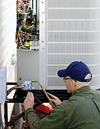
Nordyne expects 2009 heat pump sales to increase due to federal tax credits, improved technology, etc., all of which have converged to make heat pumps attractive to homeowners.
Say “heat pump” around a non-HVAC person, and they’re bound to provide some unpleasant memories. Everyone seems to know someone who had a heat pump growing up, and they can rattle off a chain of annoyances such as cold air, an overall cold house, frequent breakdowns or noise. These could all be reasons why heat pumps have held steady at around 20 percent of the entire split-system cooling market for the last two decades.
With past problems behind them, however, heat pump sales have begun to rise. They’re not ready to take over the leadership position held by air conditioners, but they’re definitely gaining ground. Their market share has swelled to 32 percent, and now with the American Recovery and Reinvestment Act federal tax credit available, manufacturers such as Nordyne are expecting heat pump sales to increase even more.
So, has the split-system ugly duckling finally shed its feathers and turned into the beautiful swan? Jeff Gamache, split system product manager at Nordyne, thinks so.
“Each year we continue to see growth in heat pump sales compared to air conditioner sales,” he said. “Historically, heat pump territory was in a band across the United States just south of Missouri and across Tennessee. That line is moving up, and we’re selling heat pumps in northern geographies that have traditionally had air conditioners.”
According to Gamache, the expanded heat pump sales market is due to a combination of factors - all of which have converged in 2009 to make heat pumps incredibly attractive to homeowners.
“First, we now have homeowners who are more educated about efficiency levels and what they mean in terms of utility costs. A smarter consumer is going to be considering all of their options - including dual fuel.
“Then we have natural gas prices rising faster than electricity, putting the long-term cost advantage towards the heat pump. And finally, we have the federal tax credit and local utility rebates that encourage heat pump adoption.”
Nordyne expects their heat pump sales to increase thanks in part to the federal tax credit.
“We’re seeing a recent increase in higher-SEER heat pump sales that we’re attributing to the tax credit,” said Gamache. “Nordyne does have a strong heat pump offering, but we’re also encouraging our dealers to promote dual fuel because of the extreme energy savings.”
Even in the weak economy, many manufacturers have seen both heat pump and air conditioner sales trend towards higher-SEER units. Meaning, homeowners who are going to spend the money on a new system want the biggest bang for the buck, and in some areas that bang is a high-SEER heat pump in a dual-fuel application.
“After a thorough analysis, we found that the average homeowner can save around $800 a year with dual fuel,” said Gamache. “We analyzed cooling and heating degree days and calculated annual utility costs for a traditional 16 SEER air conditioner and 95 percent AFUE furnace versus a 15 SEER heat pump and a 95 percent AFUE furnace. In almost all markets where a traditional furnace and air conditioner existed, the heat pump-furnace combination returned greater energy savings.
“Dual fuel makes sense for so many reasons,” explained Gamache. “It’s going to lower utility bills for homeowners, conserve our nation’s energy, and with the new federal tax credits, dual fuel is going to give homeowners more options - and possibly more cost-effective options - to take advantage of the credit.”
WHAT'S NEXT?
As heat pump popularity continues to rise, the technology is increasing right along with it. Fossil fuel kits are a thing of the past, and today’s technologically advanced thermostats make dual-fuel management and setup rather simple.Some of the most sophisticated HVAC technology is now also found in heat pump models. Nordyne launched the heat pump version of their inverter-rotary iQ Drive® this month. Using an inverter-driven rotary compressor, the heat pump achieves efficiency levels up to 22 SEER, 10 HSPF, and 15 EER.
Inverter technology is mainly found in mini-splits as it was developed for the Asian markets as a way to achieve high efficiency with very little noise. The iQ Drive is currently the only ducted application of an inverter with rotary compressor, said Nordyne. The system’s inverter component converts the electrical current from ac to dc and, in doing so, can almost infinitely vary the compressor and fan motor speeds.

Heat pump popularity continues to rise and the technology is increasing right along with it. Some of the most sophisticated HVAC technology is now also found in heat pump models.
Koesterer added that key differences between the iQ Drive heat pump and traditional models are an inverter, a rotary compressor, an electronic expansion valve instead of a TXV, and a patented controller that uses an algorithm to communicate with the inverter and adjust capacity. The controller continuously monitors the system and load requirements so that the unit is always running at the most efficient speed to match the cooling or heating load of the home.
With new technology, a growing trend towards dual fuel, and tax credits that reward homeowners for higher SEER units, forget 2009 as being the year of the ox. This very well could be the Year of the Heat Pump.
For more information, visit www.iQDrive.net.
Publication date:05/25/2009

Report Abusive Comment